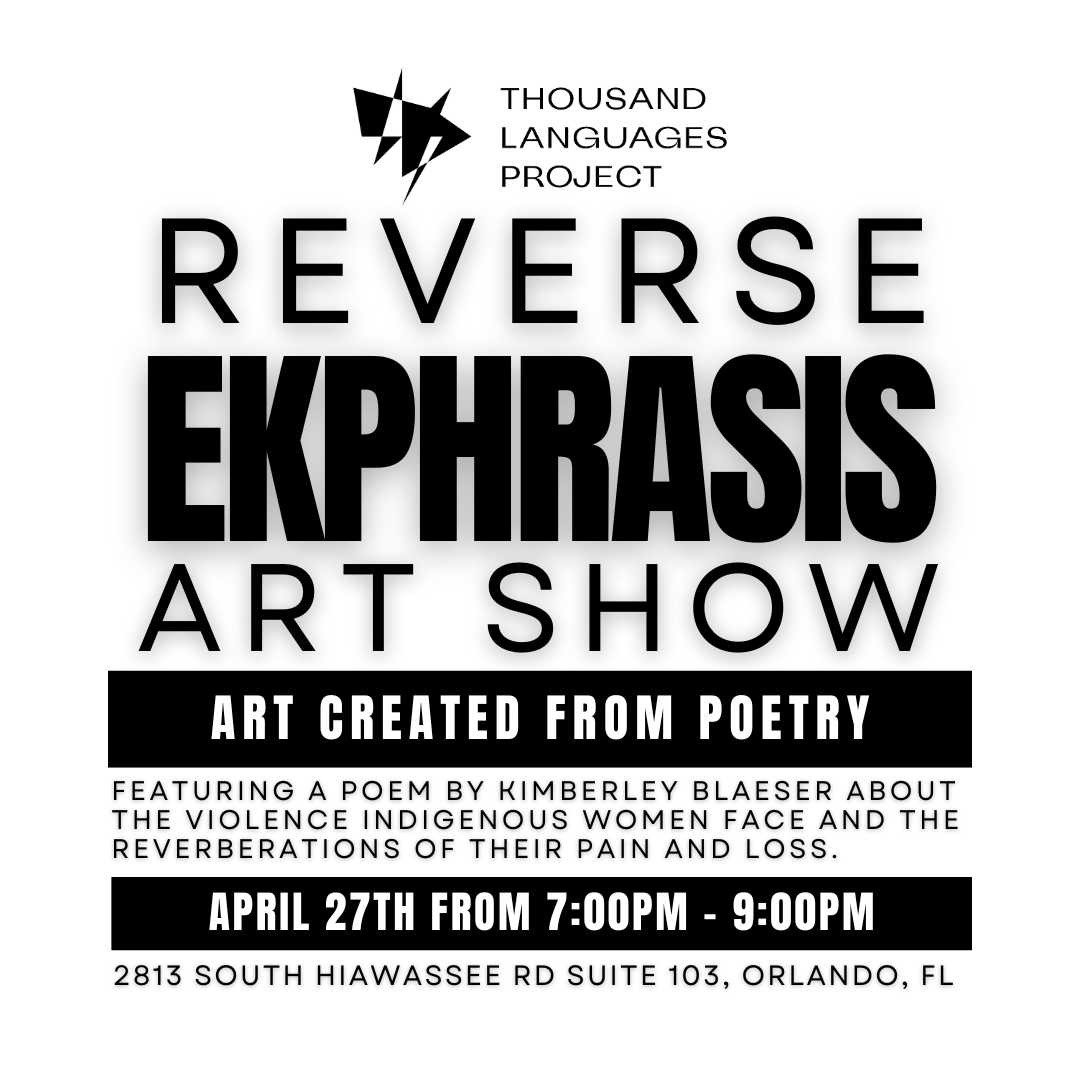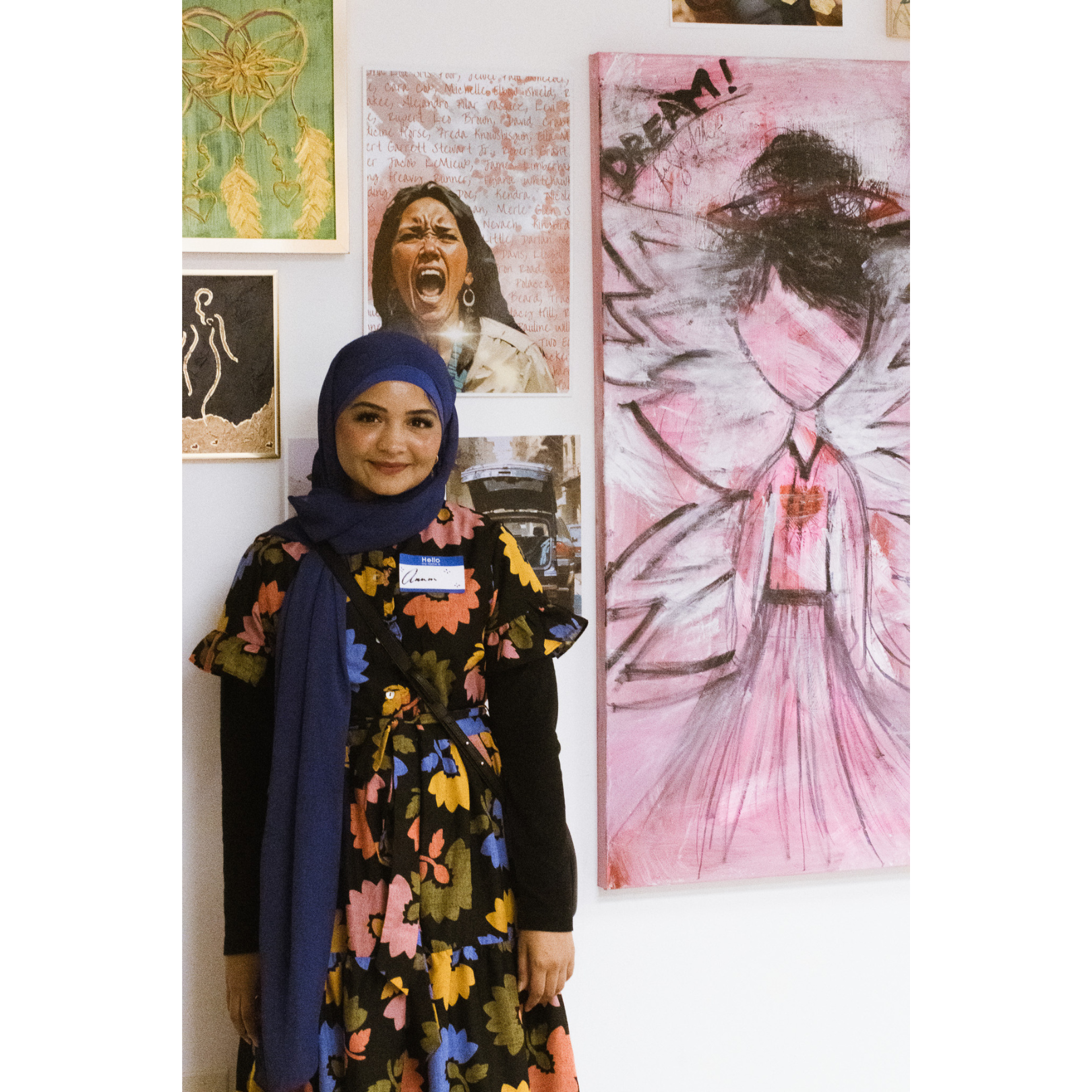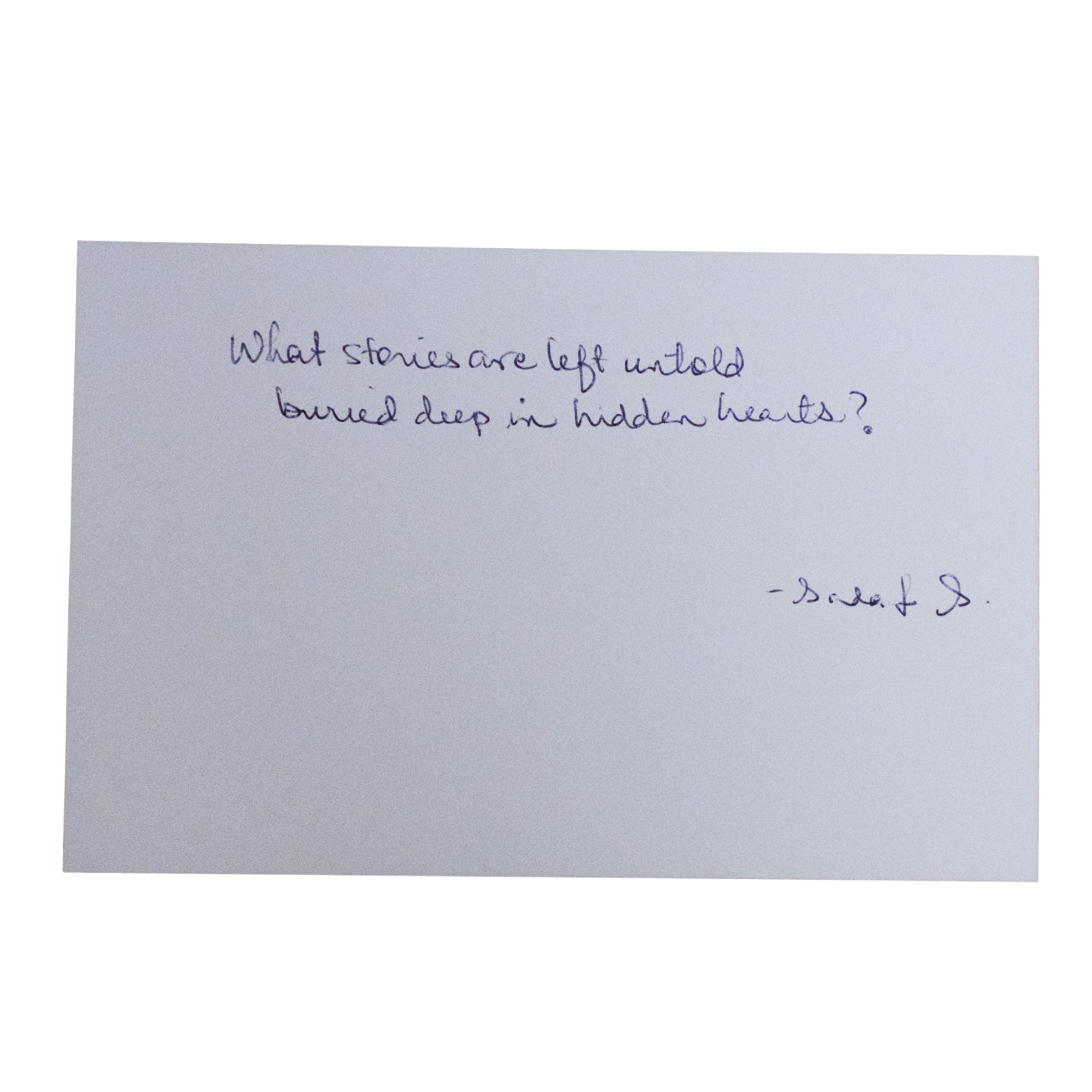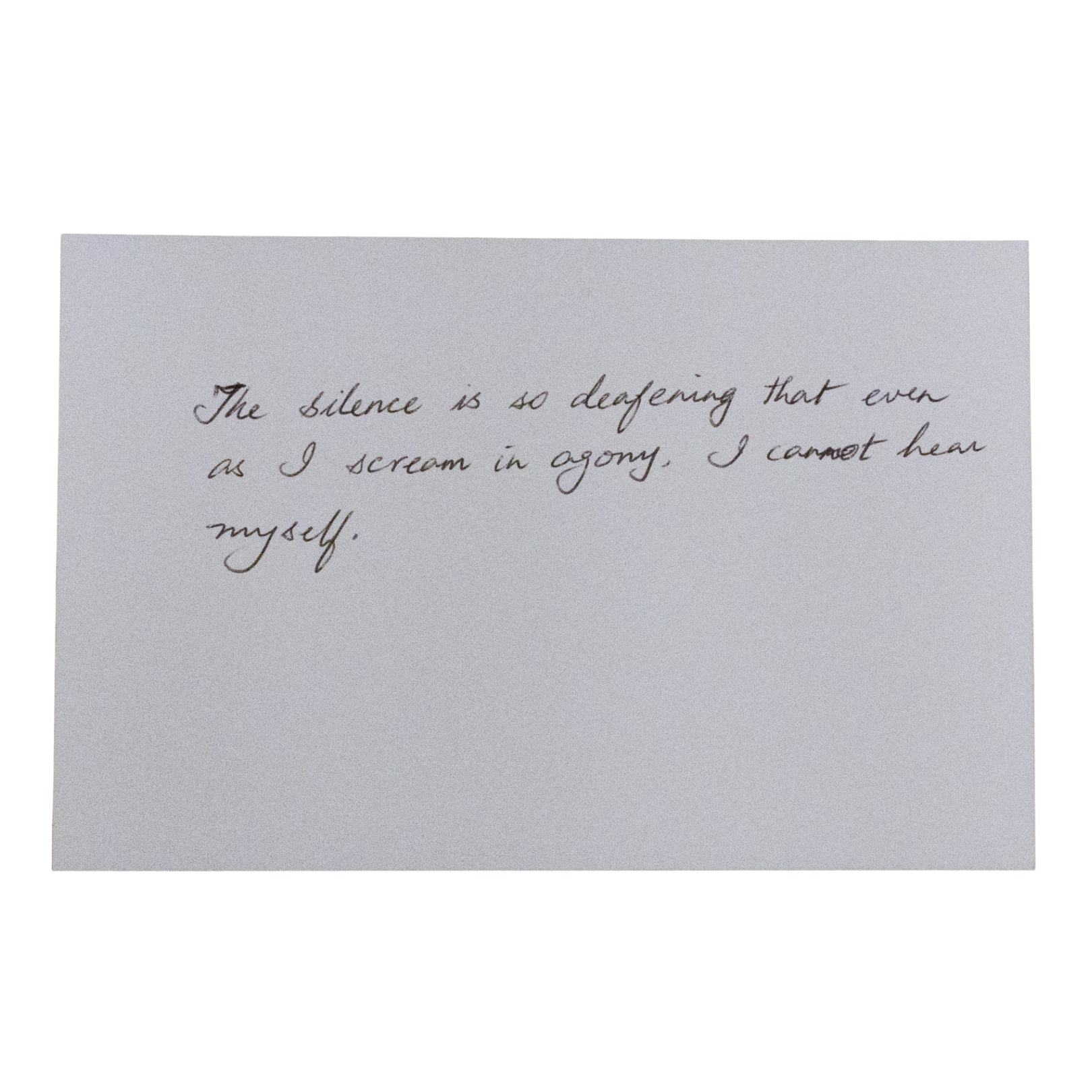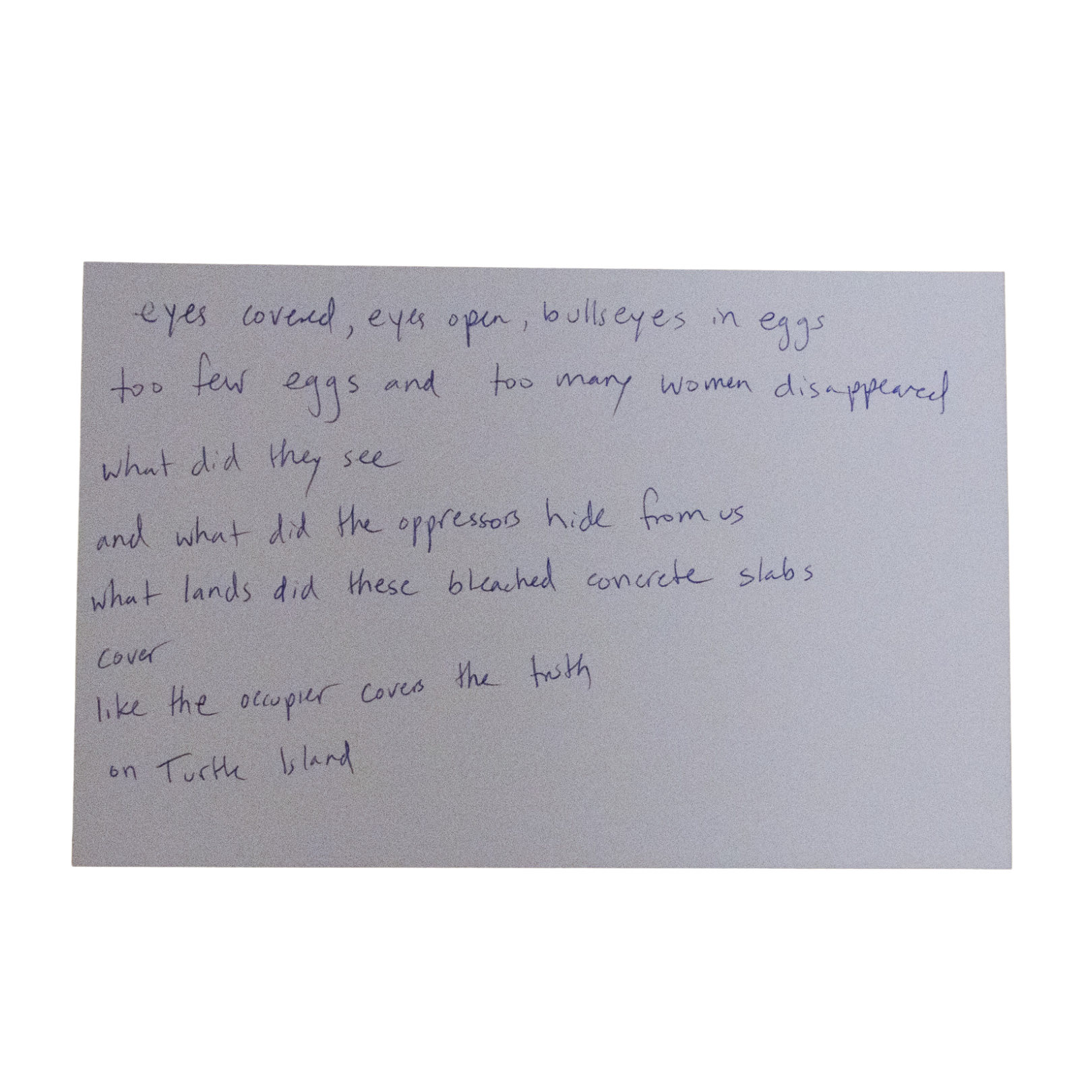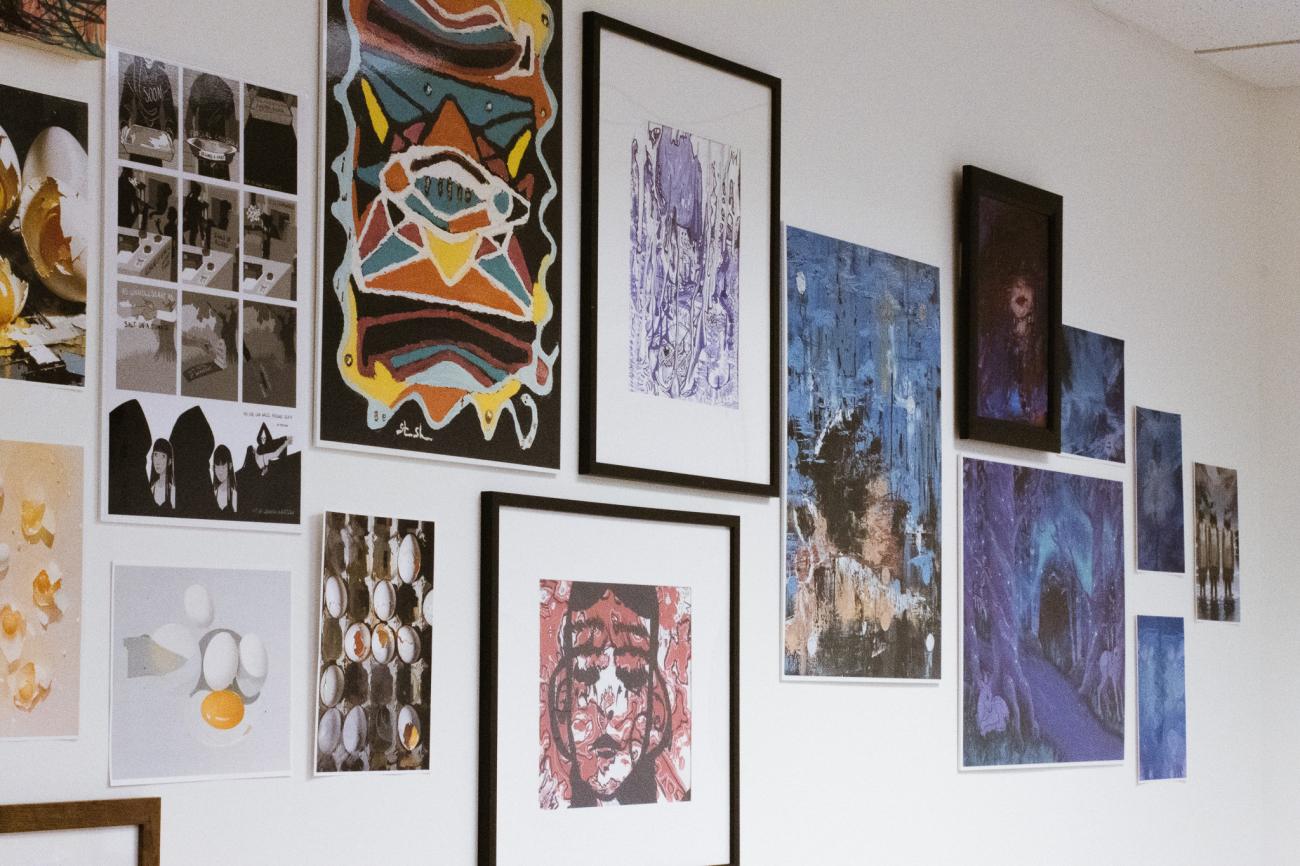
Reverse Ekphrasis Art Show
Visual artwork in response to the poem "When Her Body is a Battleground" by Kimberly Blaeser published in Hayden's Ferry Review issue 73.
Art and Poetry have a longstanding collaborative tradition in Ekphrasis [ek fray sis], the practice of writing a vivid description or poem in response to a work of art. Reverse Ekphrasis becomes the practice of creating visual representations in response to the written word. Artists focused on sensory language and metaphor to inspire their visual artworks. This show increased accessibility to literature by creating a new path of readership through the translation of literature into visual art.
The show was open to the public and took place in Orlando, Florida on April 27, 2024 featuring local and national artists of various mediums. You can find photographs of the artwork on display here as a virtual gallery.
Featured Poem
"When Her Body Is a Battleground"
i.
When ikwewag litter ditches like deer,
when girl bodies sink—skipped rocks
off greased fingers of Wiindigo.
Inademod—ribbons on our skirt a keening.
ii.
Soon funeral casserole becomes habit—
macaroni-corn-hamburger fix in cold basements.
Church bakers worry three eggs in a cake
is extravagance—unnecessary as salt
on a tomato. As two choruses of goodbye.
Her fistful of grave dirt cocked like a gun.
No one can waltz around death in the end.
iii.
When her body is a vermillion stranger
a heaving caught, target of gaze.
When her body is a battleground.
iv.
Make of your voice a search party.
We, soothsayers, know predator eyes become rivers;
smooth words, a weapon of maji-manidoog.
Only a wide open trunk means no body.
v.
She learns how survivors speak of their captors:
my fault my fault, a confiteor of grievous—
silk gown of words—bruised skin worn thin.
Our stories rot. Reek of futurelessness.
vi.
On the day she drank holy water like beer,
rammed the Ford against the wrought iron gate;
lace doilies, communion wafers multiplied
in virgin births. Ladies Aid servers looked away.
Oh Saint Nishki, patron of the Red Landless.
In death, is faith an answer or a question?
vii.
What then shall we craft of the breaking?
Weep holes in the clay of our bodies.
Only a porous heart withstands floods.
viii.
Maamawi. . . mashkogaabawiyang.*
*“Together we stand strong.” From the Strong Women’s Song created by Anishinaabe kwewag and Zhoganosh Ikwewag in the Prison for Women in Kingston, Ontario.
About the Poem
Alive and dead, we are commerce.
“When Her Body is a Battleground” recognizes the vulnerable position of Indigenous women and girls in a settler colonial state. The imperial project that employed the theory of manifest destiny to justify genocide and the theft of Indigenous homelands, continues to threaten Indigenous cultural and spiritual autonomy. Although the military conflict over land—a conflict ironically called the “Indian wars”—may have passed in this country, the dehumanization of Indigenous peoples along with the possessive mindset of colonialism renders even the bodies of Indigenous women as objects of commerce. The stance of capitalism barters our freedom, our dignity, as well as our flesh and bones. Alive and dead, we are commerce. Our bodies become the site of violence.
Re-humanize our relations.
Imagery of the poem links the MMIW crisis to the specifics of loss—girl bodies, the searches, the anger of families, broken communities. It emphasizes the everydayness of this horror—the “habit” of funerals, how we dress and sing for the murdered, the callousness with which bodies are abandoned like deer slaughtered along roadsides.
Recognizing the systems that perpetuate.
The church, social service agencies, the legal system, prisons all appear or are alluded to in the poem. Each has failed in specific ways to help protect Indigenous women or failed Indigenous victims. Is our sorrow extravagant? Have we brought this on ourselves? Is justice meted equally? We recognize those who carry out the destruction or endorse it as like the cannibal giant of myth, as evil spirits.
Survivance.
Irony introduces small moments of survival humor.
In its close, the poem gestures to the strength and solidarity of women. When stand with and support one another against patriarchy, we sing ourselves strong.
About the Author
Kimberly Blaeser, past Wisconsin Poet Laureate and founding director of In-Na-Po—Indigenous Nations Poets, is a writer, photographer, and scholar. She is the author of five poetry collections, including Copper Yearning, Apprenticed to Justice, and Résister en dansant/Ikwe-niimi: Dancing Resistance.
An Anishinaabe activist and environmentalist, Blaeser is an enrolled member of White Earth Nation who grew up on the reservation. A Professor Emerita at University of Wisconsin-Milwaukee, 2024 Mackey Chair in Creative Writing at Beloit College, and MFA faculty member for Institute of American Indian Arts, her accolades include a Lifetime Achievement Award from Native Writers’ Circle of the Americas. Her book Ancient Light is forthcoming from University of Arizona Press in 2024.

Ekphrastic Poetry written by Attendees
Gallery
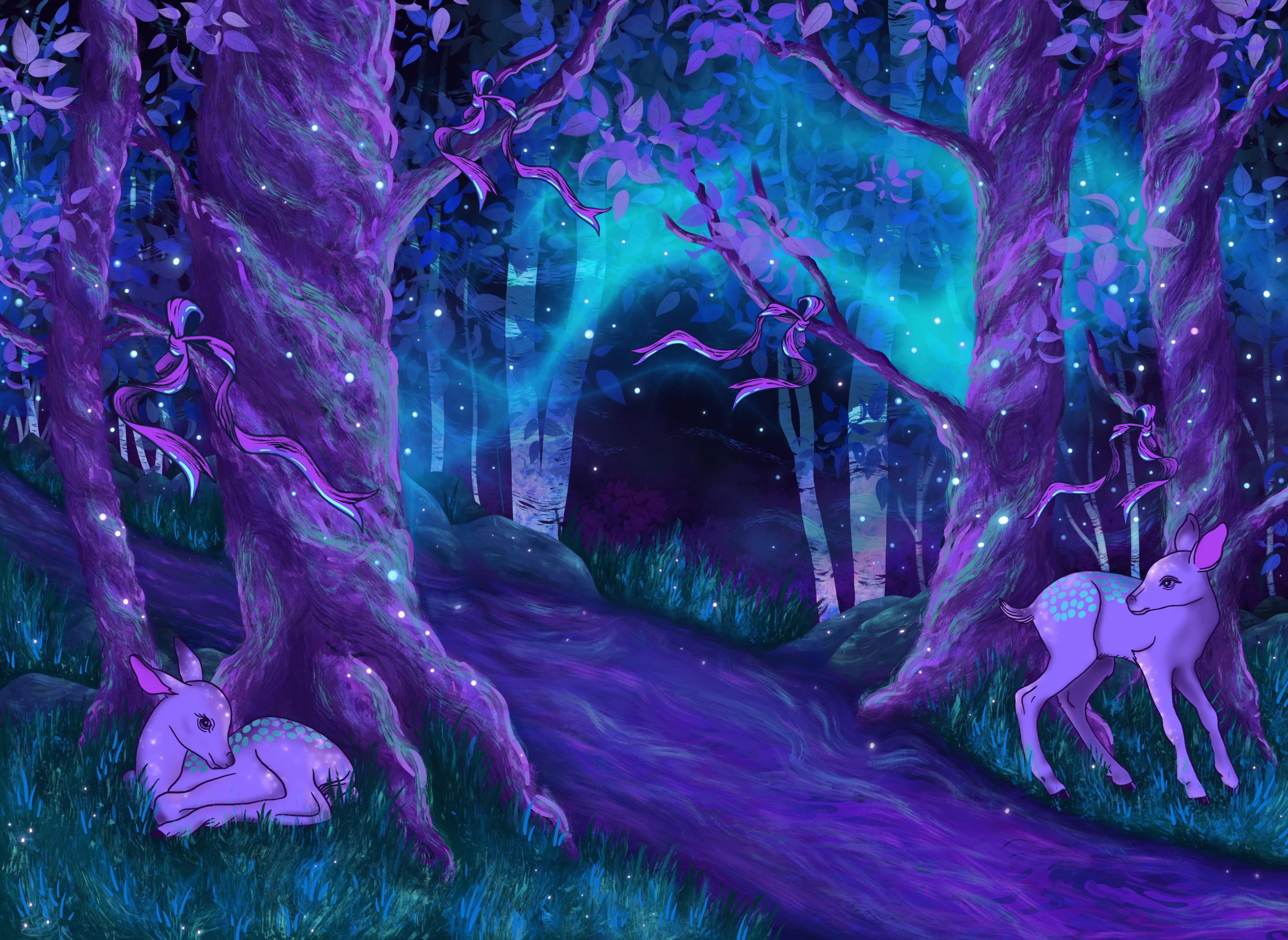
Alyssa Paxson — "Oh Dear"
Artist Statement: I wanted to create a scene that was simultaneously beautiful and hauntingly eerie, so I chose colors that calm and sooth but also speak of bruises. They're still beautiful because they cannot take away our beauty with their ugly evil deeds. The damage runs deep like a river, echoing through time, cleansing and healing, but still aching. I hope to honor those who came before me by using my art to bring attention to the violence against Indigenous women and the reverberations of that pain and loss.

Alyssa Elaskari — "بنت "bint" daughter"
Artist Statement: Through discussions with the poem's author, Kimberly Blaeser, I learned that she began writing this piece after hearing that the body of a young girl had been found in a river near the place she grew up. I was haunted by images of girls and young women's bodies in the water and wanted to present imagery that showed this terrifying scene in a way that was somewhat peaceful. While the last moments of these girls' and women's lives were met with extreme violence, I hope they found peace. It was important for me to showcase women and young children to ensure people understand this violence is being experienced by children, as well as adults.

Anum Shaikh — "Echoes of pain: Native Woman in the USA"
Artist Statement: “Echoes of pain: Native Woman in the USA” is an abstract acrylic painting where I deliberately used red, blue, shimmering glitter, and stars reminiscent of the American flag. I invite viewers to contemplate the struggles Native American women face while living in the United States of America.

Chanelle Lana Hoshnic
Artist Statement: In my artwork, I explore the relationship between faith, identity, and societal norms through abstract forms and symbolic imagery. Inspired by the poem "When Her Body is a Battleground" by Kimberly Blaeser, my piece delves into the complexities of human experience and existential inquiry. The artwork features a woman's head silhouette, symbolizing the individual grappling with mortality and spirituality. The artwork blurs the boundaries between representation and abstraction, inviting viewers to contemplate the layers of meaning. The juxtaposition of religious symbolism with unconventional behavior challenges preconceived notions and encourages dialogue about faith and belief systems. The artwork serves as a conduit for reflection, inviting viewers to explore the intricate tapestry of human experience and the quest for meaning in the face of mortality.

Aiman Shaikh
Artist Statement: "What makes someone who they are?” is the question that ran through my mind when making this piece. The idea of a person being molded into their true self was translated as this mix of patterns, strokes, and drips seen in this art piece. The inspiration came from how Native Americans are subject to such change in life. Purple is also a symbol of wisdom and mystery to Native Americans.
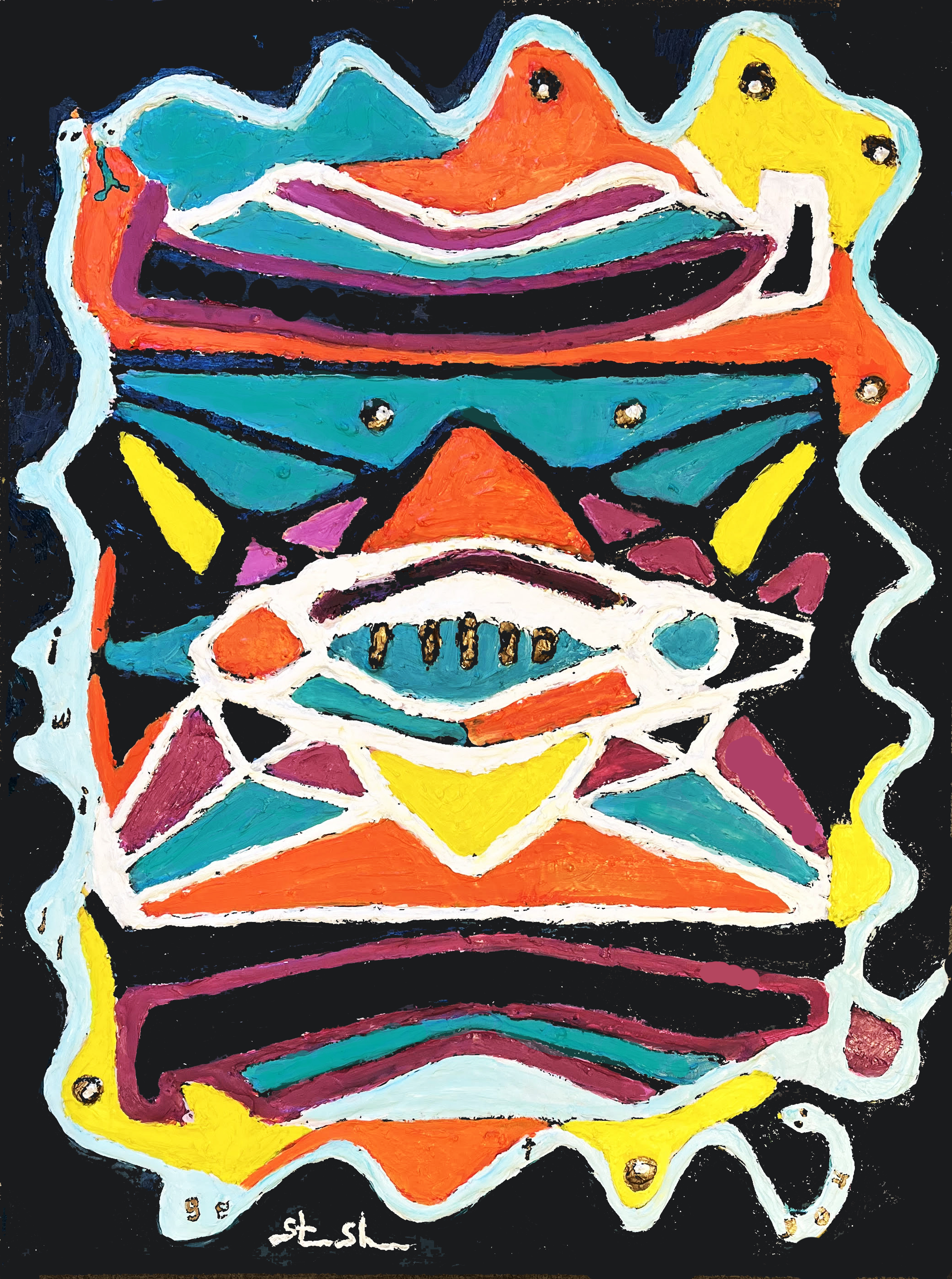
Steve Shear
Artist Statement: This painting represents the Wiindigo, a cannibalistic giant or monster. You can find the words "I will get you" on the snakes that encircle the piece. The gold teeth at the center anchor the piece.
I began painting again in 2020. I turned to color and shapes rather than portraiture and figure. My paint is applied in thick layers exaggerated even more so by multiple layers of glue serving as an underpinning. The glue not only adds thickness to the paint but also runs in ways which produces unique shapes that take on lives of their own.
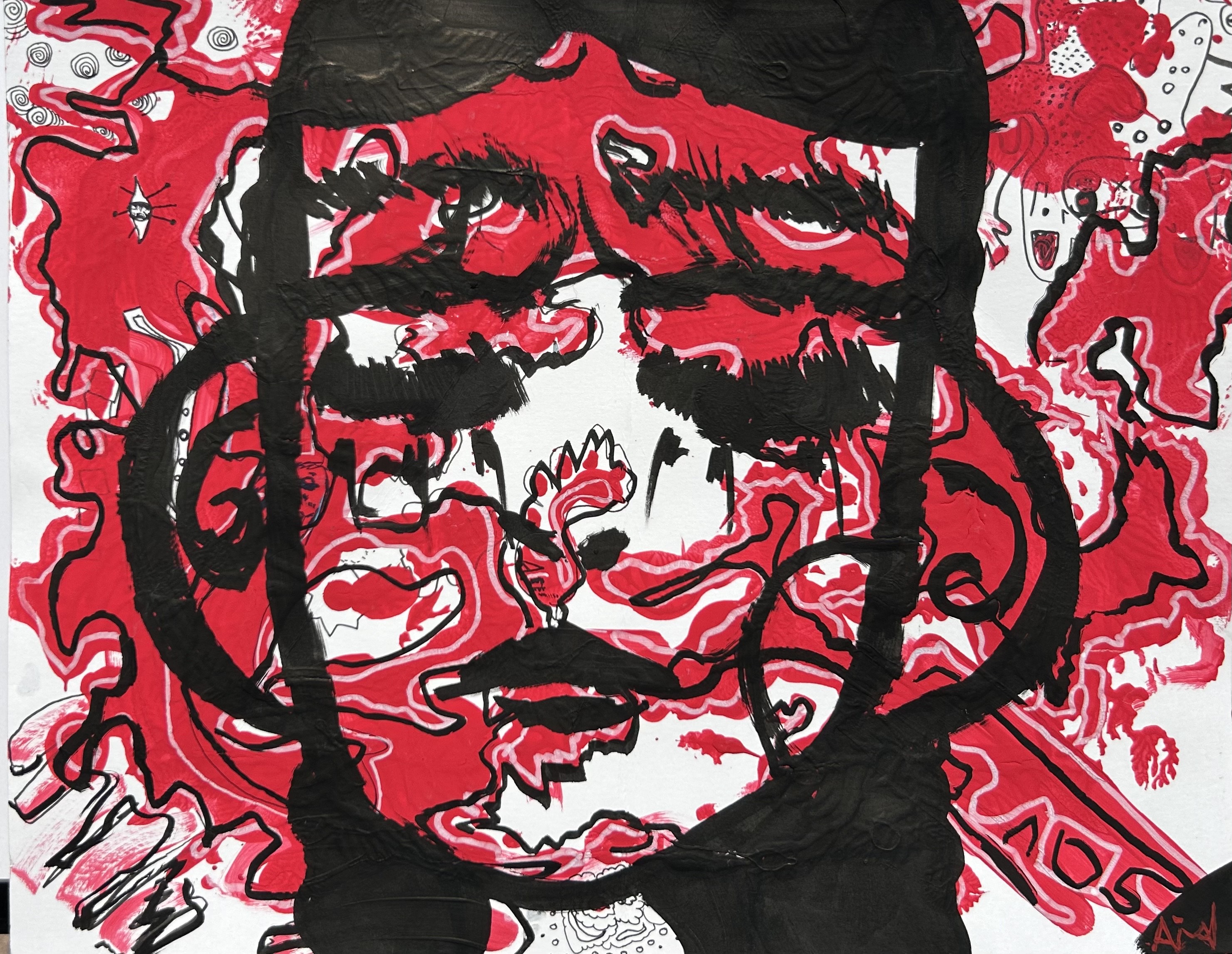
Aiman Shaikh
Artist Statement: This piece represents the power of a Native American woman. When creating this piece I had emotions of confidence in mind.The heavy red color is symbolic to the resilience, courage and creativity of a Native American woman.
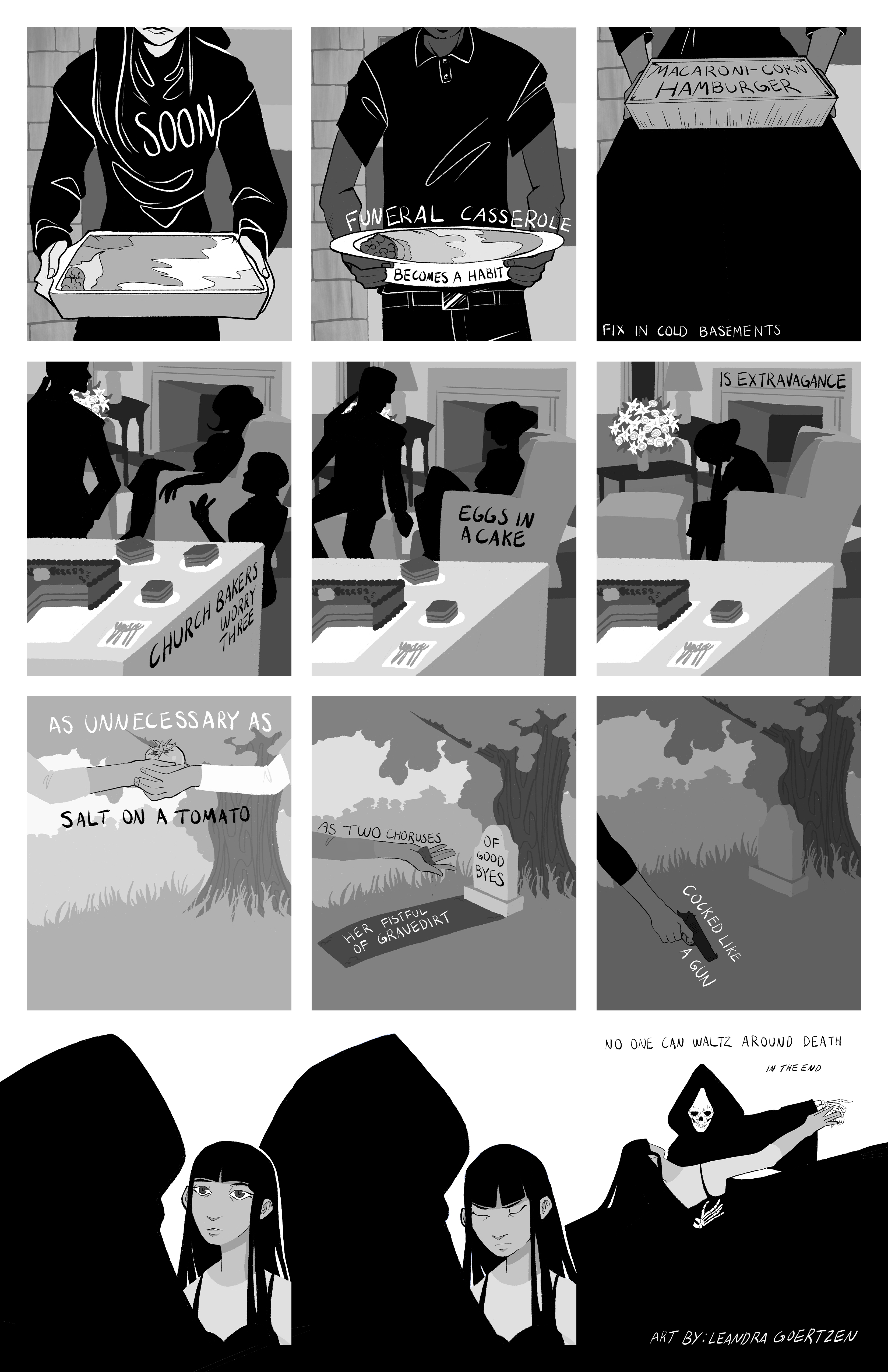
Leandra Goertzen
Artist Statement: This piece is a representation of part ii using a graphic novel style of art. It ends with a depiction of a woman waltzing with death.
Excerpt from Kimberly Blaeser's poem:
ii.
Soon funeral casserole becomes habit—
macaroni-corn-hamburger fix in cold basements.
Church bakers worry three eggs in a cake
is extravagance—unnecessary as salt
on a tomato. As two choruses of goodbye.
Her fistful of grave dirt cocked like a gun.
No one can waltz around death in the end.

Alyssa Elaskari — "بيضة "bayd" egg"
Artist Statement: I was struck by the idea that three eggs for a cake could become an extravagance of mourning. When I further considered how mourning might be misconstrued as excessive, I decided to play with the visuals of broken eggs in an attempt to show both the everyday-ness and the brokenness of this concept. I preferred a blend of photography and virtual art because I wanted to make it clear that this is a real life problem that requires action, not one left to an imaginary realm or fantasy.

Anum Shaikh — "Strength amidst sorrow: Portrait of a Native Woman"
Artist Statement: “Strength amidst sorrow: Portrait of a Native Woman” shows the graceful nature of an indigenous woman who, despite the turmoil surrounding her, wears a gentle smile. By using markers on a wood panel, I honor and show the strength and beauty of a Native American woman.

Aiman Shaikh
Artist Statement: This art piece was super fun to make. The unique cultural accessories and face designs of native heritage can be seen in this cute girl. The girl’s ears are exaggerated to highlight the intuitive charm of a free spirited Native American.

Anum Shaikh — "Pink Spirit Guardian"
Artist Statement: “Pink Spirit Guardian” was a healing piece for me to make. I honor the resilience of Indigenous women who continue to dream and heal others despite their heartbreak and the trials they face.
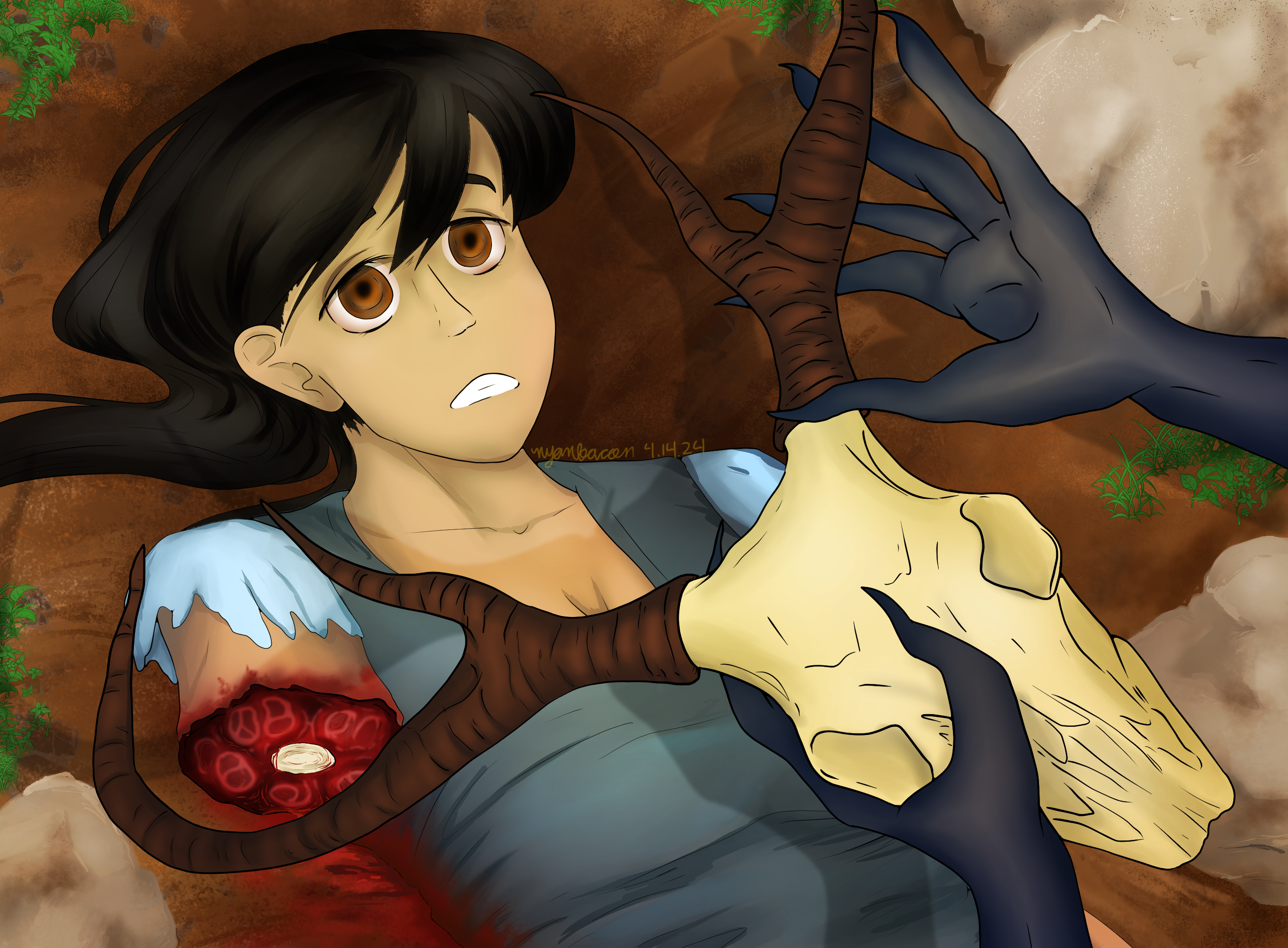
Anastasia "Andy" Friesen — "In a ditch lies a dead girl, missing an arm. A Wendigo places a dear skull over her face as a parting gift."
Artist Statement: The Wendigo serves as a symbol of the colonizers who are killing the Indigenous population in North America. The girl has had her arm removed and eaten by the cannibalistic spirit, stopping her from reaching the spirit world. The Wendigo places a deer skull upon her face, masking her glassy-eyed death with a symbol of gracefulness and peace. The gruesome truth is hidden beneath the colonizer’s secret-keeping.

Anum Shaikh — "Wisdom Box"
Artist Statement: My art piece, “Wisdom Box” contains imagery such as a white wolf with pain in his eyes, an exhausted tipi, and an electrifying dreamcatcher. I invite viewers to think about the enduring strength and spirituality of Native Americans.

Alyssa Elaskari — "Missing & Murdered Indigenous People"
Artist Statement: Two lines that haunted me long after reading "When Her Body is a Battleground" were "make of your voice a search party" and "only an open trunk means no body." These pieces speak to the current list of Missing and Murdered Indigenous People (MMIP). In one piece a woman cries out, a light echoing from her mouth illuminates the power of her voice and the hope that light is shed on this issue. The names of currently missing Indigenous people are listed behind her. This list can be found at https://www.bia.gov/service/mmu. The other pieces feature cars with open and empty trunks. They are eery and mundane at the same time. They are meant to pay homage to those whose bodies have been discarded and carried in the trunks of vehicles.

Anum Shaikh — "Golden Heartbeats"
Artist Statement: While creating “Golden Heartbeats,” I intentionally chose to make the dreamcatcher a heart shape to represent the love and collective resilience within indigenous communities. I invite viewers to be reminded of the enduring bonds between Indigenous women and the interconnectedness of their experiences.

Waheeda Shaikh
Artist Statement: After reading "When Her Body is a Battleground" by Kimberley Blaeser, I felt a very dark mood settling upon me. Being an avid reader, I love being immersed in the words in front of me but not this time. What stood out to me was how the violence against women was made ordinary and trivial in Ms. Blaeser's imagery. The mention of everyday food made it like an everyday affair ironically. I couldn't get past the mention of funerals, food and the other run of the mill, ordinary things juxtaposed together with such a somber situation.
I have used a black textured background for my art to represent the idea of broken women of color, bruised skin, families fragmented from loss, and the darkness that settles over an unexpected, tragic loss. The vermillion represents the danger and the violence of this poem's theme. The gold leaf is symbolic for the armor we wear as women in a patriarchal world. It is there, but it is not enough because of how systemic and universal this problem is. Growing up in India, I was exposed to stories of tribal and rural women facing this kind of fate quite often. Lastly the hearts are for all the women who have been lost and buried over time.

Anum Shaikh — "Hearts Dance with Red and White"
Artist Statement: In “Hearts Dance with Red and White”, I used red and white acrylic paint as well as bright yellow glitter as symbols of Indigenous women’s steadfast strength and beauty. I invite viewers to remember the vibrant presence and unwavering spirit of Native American women.

Ayesha Shaikh — "Survivor"
Artist Statement: I was delighted to make this piece. My favorite part was painting the Native American woman. I intentionally added gold paint to bring an energy of richness and confidence to this piece.
Meet the Artists
Alyssa Paxson

It’s always been art for Alyssa Paxson, starting with a love of dance as a little girl, playing the flute in bands and orchestras into young adulthood, and onto visual arts in college and beyond. Alyssa is a native Floridian with Oglala Lakota and Cherokee ancestry, among others. She has a BFA in Fine Art from Florida Southern College, and primarily works in oil paint since 2003. Alyssa lives in Lakeland with her husband, Russ and son, Fox. Most recently she is exploring digital art and preparing to launch an online shop with art prints, stickers, and more.
Anum Shaikh

Anum Shaikh, a Pakistani-American artist in her mid-twenties, graduated from the University of Central Florida with a unique artistic style that blends her academic background with her cultural heritage. Her vibrant paintings reflect the duality of her identity, combining traditional elements with modern American influences. Driven by a passion for women's rights and social justice, Anum's artwork conveys powerful stories that encourage viewers to reflect on important issues. Her art inspires and advocates for change while challenging societal norms.
Chanelle Lana Hoshnic

Chanelle Lana Hoshnic, a contemporary artist from Arizona, is known for her abstract paintings that explores deep into human emotion and experiences. Born into a vibrant upbringing, her passion for color, form, and expression ignited her artistic journey. Drawing from fine arts, her work features bold, expressive styles with vivid hues and dynamic brushstrokes, which captive the viewer’s imagination.
Aiman Shaikh

Aiman Shaikh is a 22 year old emerging artist whose vibrant creations captivate audiences with their emotional depth and originality. Aiman's artistic journey began as a means of self-expression and exploration of the human experience. Standing out from her peers motivated her to focus and contemplate on the depths of being different. Through her dynamic use of color, texture, and symbolism, Aiman invites viewers to introspect, ponder life's complexities and beauty through their personal perspectives of her art. Whether through collaborations, community projects, or advocacy, Aiman makes art as a catalyst for awareness, change and connection.
Waheeda Shaikh

Waheeda Shaikh was born and raised in India and Oman. She lives in Orlando with her husband and two children. After graduating with a degree in English Literature and another in Education, she now teaches ESL at a local college working with adults who have recently emigrated to the United States.
She started painting during Covid and does mainly abstract art, glass painting, calligraphy and gold leaf work. Her instagram is #gildedartistry.
Ayesha Shaikh

Ayesha Shaikh, a Pakistani-American artist, has been painting since she was a young child. Balancing the roles of wife, mother to four children, and devoted artist, Ayesha infuses her work with the rich tapestry of her Pakistani heritage and the dynamic spirit of her American experience. Ayesha's work reflects her Pakistani heritage and her American experiences. Each painting adds to the story of her life and her journey as an artist. She inspires her children to be artists as well.
Leandra Goertzen

Leandra Goertzen, an ASU student working towards a Bachelor's Degree in English Linguistics, is a graduate of Pratt Institute with an Associates in Illustration.
Steve Shear
Steve Shear was previously represented by the Z-Wolf Gallery in Denver, Colorado and The Boulder Art Gallery in Boulder, Colorado as well as galleries in Tucson, Arizona and Brentwood, California. Much of his work can be viewed at www.steveshear.net. He spent five years painting under the watchful eyes of Jean Packard, a graduate of the Chicago Art Institute, two summers at the Charles Cecil Art Studio in Florence, Italy, and several years at the Boulder Art Academy in Boulder, Colorado. He also trained in sculpting under Valentin Okorokov. All in all, he has been painting since 1986. In 2013 he began writing, first poetry then novels, screenplays, and stage plays. Six of his novels and two stage plays have been published.
Anastasia "Andy" Friesen
This project is led by TLP Intern Alyssa Elaskari
About Alyssa
Alyssa Elaskari, an intern at Thousand Languages Project, is completing her master’s in English. Her Arabic translations of three poems written by recipients of the Indigenous Poet’s Prize will be featured in Issue 4. While working on the translation of “When Her Body is a Battleground,” she was inspired to develop a special event that could connect her local community in Florida to the work being done at ASU. As a survivor of sexual assault and the Community Manager of a non-profit dedicated to creating compassionate spaces that meet the needs of Muslim women in Central Florida, Alyssa works to build awareness and advocate for women who have experienced violence. She also understands that domestic violence, sexual assault, stalking, and sex trafficking disproportionately affect Indigenous women, girls, and two-spirit individuals. She hopes this project increases awareness of the Missing and Murdered Indigenous Peoples crisis and encourages the practice of ekphrasis and reverse ekphrasis.
